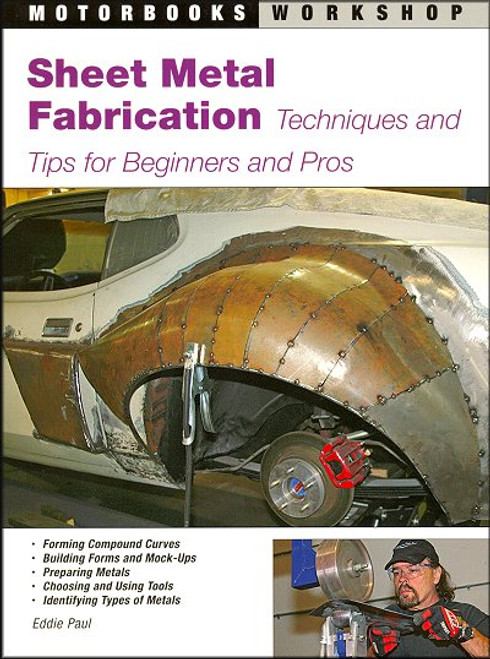If you want to build a hot rod, customize or modify a car or truck, a motorcycle, or restore any vehicle, knowing how to form sheet metal is a crucial skill.
The Motor Bookstore is proud to offer this book by Matt Joseph, a well-known and popular automotive author.
From making door skins, hoods, fenders, trunk lids, roofs and many other components, the first thing you will need is a clear understanding on the subject, and that's when Automotive Sheet Metal Forming & Fabrication comes in.
Packed with easy-to-understand text accompanied by sharp, detailed color photos, this is the reference you'll want by your side to show you the information you'll need to learn before you start forming your first piece of sheet metal.
Book Excerpt: Automotive Sheet Metal Forming and Fabrication AUTO BODY METAL
We think of auto body metal in different ways. When we view it as finished parts and panels, formed into consistent contours with smooth shades and accurate creases and coated with shiny finishes, we regard it as something very hard and immoveable. We see it as a rigid, static material, one that yields only to great force by crumpling into chaotic disarray. There is another way of considering steel and aluminum panel materials - malleable stuff that can be moved and persuaded, incrementally into consistent auto body panel shapes. In this view, these materials are almost endlessly formable by various mechanical processes. Some of those processes are wonderfully automated. In manufacturing, a stamping or rolling press can take flat sheet stock and force it into door skins, fenders, hoods, and the like, in one (or a few) quick operation(s). What is not seen in that sequence is the great ingenuity and effort that go into designing and fabricating the dies for the stamping or transfer presses that shape the metal. Also unseen are the time and effort spent refining the results of those forming processes to near perfection. There is also the craft of custom fabrication. This pertains to the forming of sheet metal with hammers, anvils, shot bags, wooden hammer forms, power hammers, English wheels, and numerous other devices used to work individual pieces of panel stock, one panel at a time. This work is an intricate combination of art and science, of applied force and fine judgment. It requires close observation, creativity, ingenuity, daring, restraint, and experience. It is the metal formers' craft. Success in this craft depends largely on the characteristics of the metal panel stock. If you fight those characteristics, your results probably will look crude, lack durability, and require excessive time to accomplish.The aim of this how-to book is to show you, the reader, how to perform most of the basic operations used in metal forming and fabrication. But author Matt Joseph also explains the reasons why he does certain things in a certain way. And although some of the most exotic tools and equipment also get their share of attention, the focus of the book is on the reliable basics. Subject: Automotive sheet metal forming and fabrication. ISBN-10: 1613251718 | ISBN-13: 9781613251713 | CarTech SA196P
TABLE of CONTENTS:
- FIRST CONSIDERATIONS
- A wide range of possible projects
- Limits of material, skills and imagination
- Subtle factors to consider
- AUTO BODY METAL
- Characteristics of sheet metal
- Alloys: steel and aluminum
- Work hardening and strengthening
- Workability
- Heating and annealing
- Selecting metals and their alloys
- Acquiring metal stock
- THE ART of MAKING SHEET METAL WORK WITH YOU
- Basic theories of metal forming
- Bilaterism and other tricks
- The importance of good foundations
- PLANNING and IMPLEMENTING
- Choosing constructions, materials and tools
- Modeling, patterning and templating
- Measuring, drawing and laying out work
- Structural vs. nonstructural fabrications
- MAJOR FORMING and FABRICATING PROCESSES
- Cutting
- Simple bending
- Flanging
- Creating the correct crown
- Wheeling
- Power hammer forming
- Avoiding unnecessary damage
- OTHER PROCESSES and SKILLS
- Filing
- Sanding
- Edge deburring
- Drilling, piercing and punching
- Edge treatments and bead rolling
- Louvers and exotic trim formations
- Using tension
- FINISHING PROCESSES and TOUCHES
- Checking final dimensions, contours and attachments
- Weld finishing
- Metal finishing
- Checking metal integrity
- FILLING with LEAD and PLASTIC
- Four types of filler
- Proper filler application
- Proper shaping and smoothing techniques
- Proper surface preparation
- TOOLS and EQUIPMENT
- Hand and vise tools
- Specialty tools
- Clamping and fixturing tools
- Making special-purpose hand tools
- Small equipment
- Multi-purpose devices
- Power and hand tools
- Blacksmith tools
- THE ART of the ENGLISH WHEEL
- Using an English Wheel
- Effective versus harmful techniques
- POWER-OPERATED MACHINES
- Power hammers
- Big machine basics
- Special power hammer tooling
- METHODS of ATTACHMENT
- Non-welding jointure techniques
- Welding
- Tips for fabrication welds
- SMALL DEMONSTRATION PROJECT: THE LITTLE BLACK BOX
- Meet the Little Black Box
- The basic plan
- Preliminaries
- Forming the top piece
- Making the skirt
- Assembling the two pieces
- LARGE DEMONSTRATION PROJECT: FENDER FABRICATION
- Planning and patterning
- Fabricating the side section
- Fabricating the top section
- Joining the two pieces
- Wire edging and fender panel
- Making support and base brackets
- APPENDIX
- Radiated colors
- Gauge specifications










